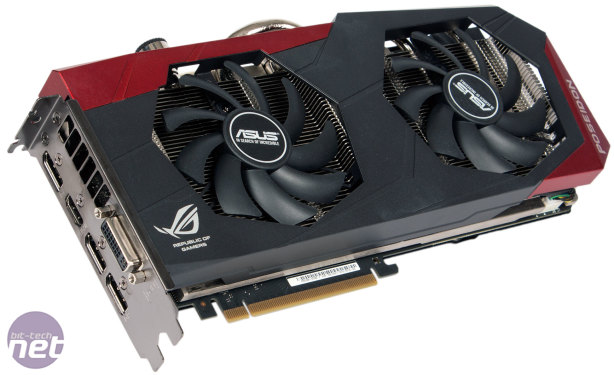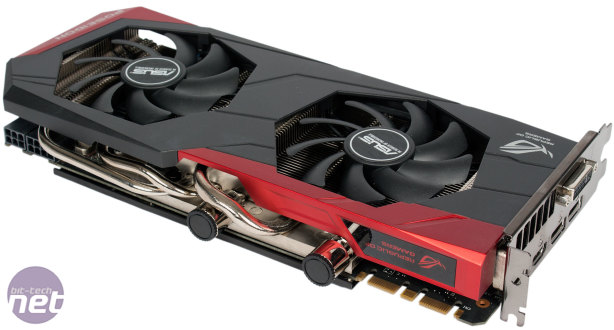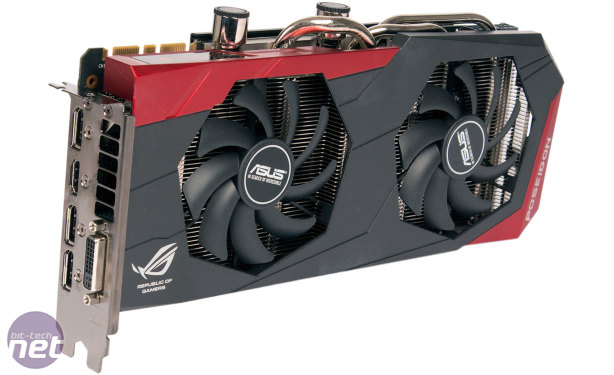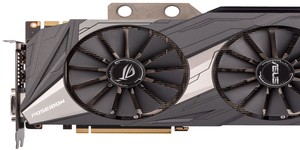
Performance Analysis
The GTX 980 Poseidon Platinum has the same clock speeds as the Strix GTX 980, but it does perform a little better in general, albeit only by a few fps each time. Asus may be using a slightly more aggressive boost profile here, and Nvidia's drivers have also been updated since we tested the Strix card.The card has smooth frame rates in Battlefield 4 at 1440p and the overclock is enough for it to stay at or above 30fps at 4K too – only the Galax GTX 980 SOC, which has a higher factory overclock, has managed this feat so far. The Poseidon Platinum sails through BioShock Infinite at 1440p too with a 77fps minimum. At 4K, this drops to 38fps, which is bettered by the faster Gigabyte and Galax cards.
Impressively, this Asus card achieves the best single GPU result in both Crysis 3 and Skyrim at 1440p, though it cannot maintain this at 4K. At this resolution, all single GPU cards are currently unplayable in the ultra-demanding Crysis 3 benchmark, but in Skyrim the card hits a 57fps minimum, narrowly missing out on staying at or above the all-important 60fps line.
In Unigine Valley the Poseidon Platinum is 3 percent quicker than the Strix GTX 980 at both 1080p and 1440p. Gigabyte and Galax, with their higher clock speeds, still lead the pack, but there's very little in it.
Unsurprisingly, this card has virtually identical power consumption to the Strix GTX 980 – their clock speeds and PCB are the same after all. The card draws about 20W more than a reference model as a result of its modest overclock, but this is still less than a GTX 770 consumes, in case you needed reminding of Maxwell's efficiency.
In air-cooled mode, the thermal performance is certainly very good, though the load delta T of 49°C is bettered by the Strix GTX 980 with its dedicated air cooler, which is also a little quieter. When water-cooled, however, it is of course unmatched, with a delta T of just 26°C when using our 240mm radiator loop. It's likely you could run the fans on our particular setup at 5V or 7V and achieve similar results too, so there's definitely a case for water cooling to keep noise to extremely low levels as well as significantly decreasing temperatures.
Overclocking the card on air saw performance increased by between 12 and 15 percent, with the Poseidon Platinum joining the overclocked Strix GTX 980 for the best result in Battlfield 4 at 1440p and also managing the best single GPU result so far in Unigine Valley too. That said, in terms of real-world performance, you're unlikely to be able to tell the difference between the overclocked GTX 980s that we've compared it to.
When water-cooling, stock performance is virtually identical, with Unigine Valley's score only increasing by 21 points, which is less than 1 percent, indicating that when using air the GPU is not hindered in its ability to boost. Meanwhile, with the slightly higher overclock using liquid cooling, we saw a 1fps increase in the Battlefield 4 minimum frame rate, and 2fps on average, but no change at all in Crysis 3 and an improvement of just under 2 percent in Unigine Valley. Water-cooling did help us reach higher clock speeds, but the improvement is so slight as to be unnoticeable in anything but a benchmark.
Conclusion
Asus is no stranger to producing unique graphics cards with high quality engineering. With its upgraded, Super Alloy Power components in a large 10-phase system, a premium construction with a high quality backplate and a unique hybrid cooler, we can't deny that the Poseidon Platinum is a great graphics card.That said, there are plenty of great GTX 980s available for a lot less money, including Asus's own Strix model, so it's important to look at who the Poseidon Platinum is actually for. Of course, if you have zero interest in liquid cooling, it's pointless to spend this much on a GTX 980, but this card targets a niche set of consumers, namely those looking to liquid cool a GTX 980 with minimum hassle, or who are happy with air cooling for now but want an easy route into liquid cooling in the future. It can thus be seen as a good match for Asus's own Maximus VII Formula, both aesthetically and in the sense of future proofing for water-cooling.
If you're confident with liquid cooling already, you can buy a reference GTX 980 and a suitable waterblock for £500. Of course, this will void the card's warranty, but it's also possible to buy a pre-built liquid cooled GTX 980 from Overclockers UK for £520 which comes with a two year warranty, for example. For another £20, this Asus card has an extra year of warranty as well as the upgraded Super Alloy Power components and DIGI+ VRM circuitry, although this doesn't appear to make much difference to overclocking potential, at least based on the GTX 980s we've seen. Nevertheless, if you're set on buying an Asus ROG-branded GTX 980, whether for quality, aesthetics, or both, then this is actually the least expensive way to also water-cool it – buying the Strix GTX 980 and a water block for it will set you back around £570 and cost you your warranty, and OcUK's in-warranty, pre-built version is a whopping £610. As such, it neatly and successfully fills in a very small niche in the market.

-
Performance39 / 40
-
Features29 / 30
-
Value18 / 30


MSI MPG Velox 100R Chassis Review
October 14 2021 | 15:04











Want to comment? Please log in.